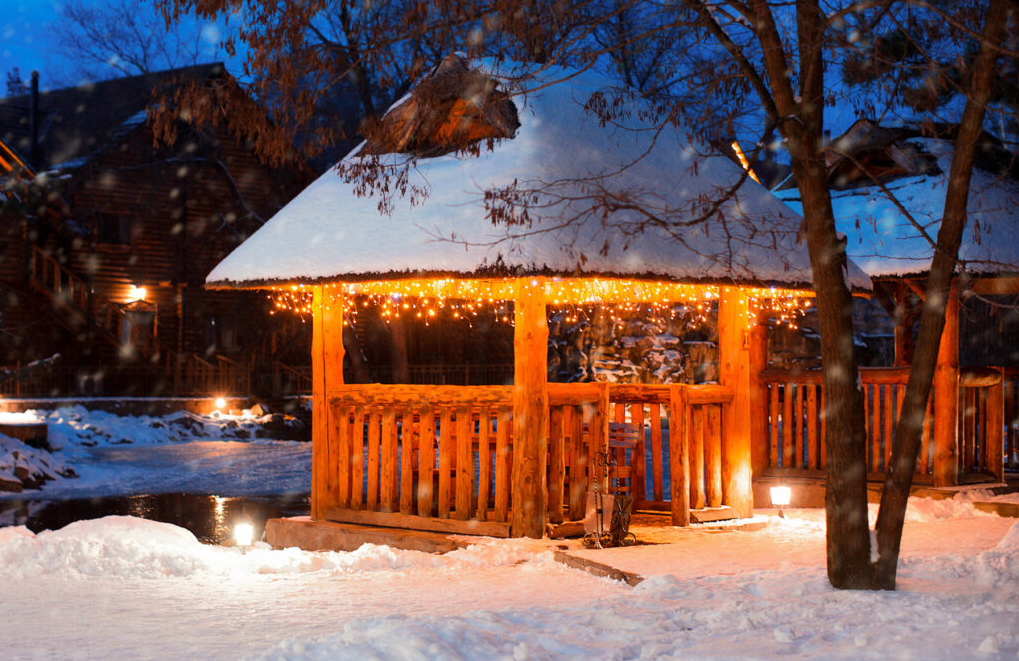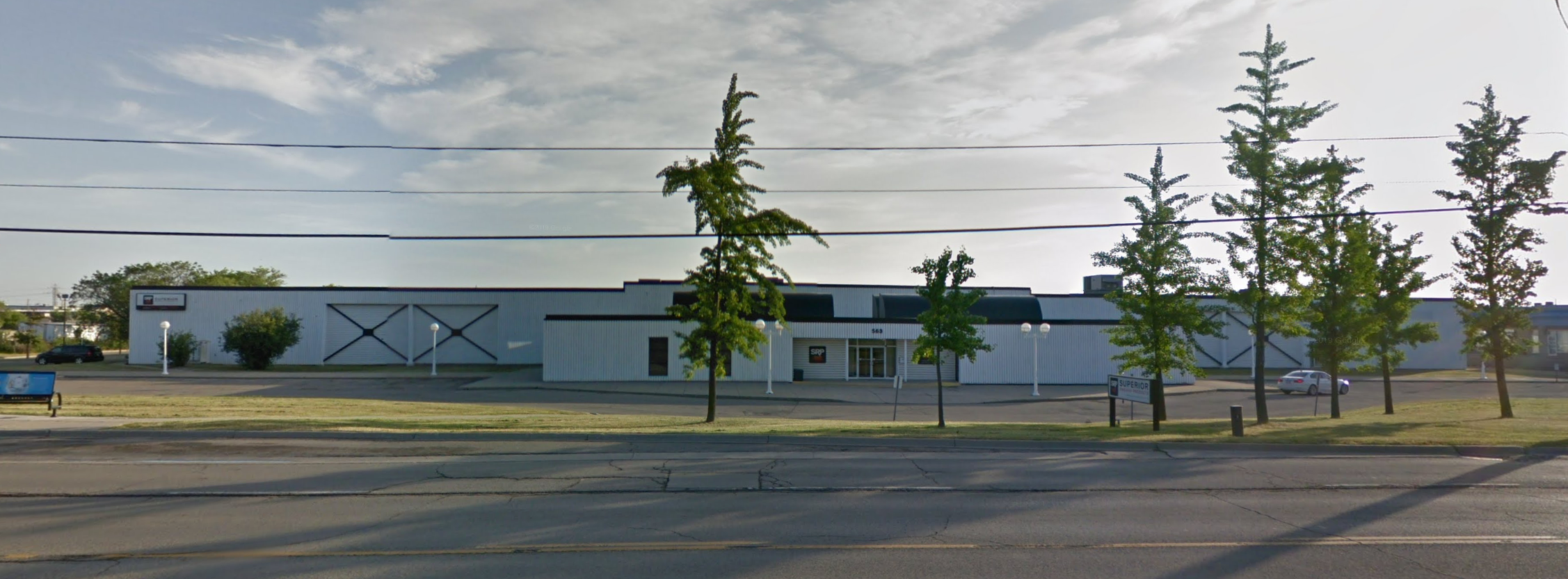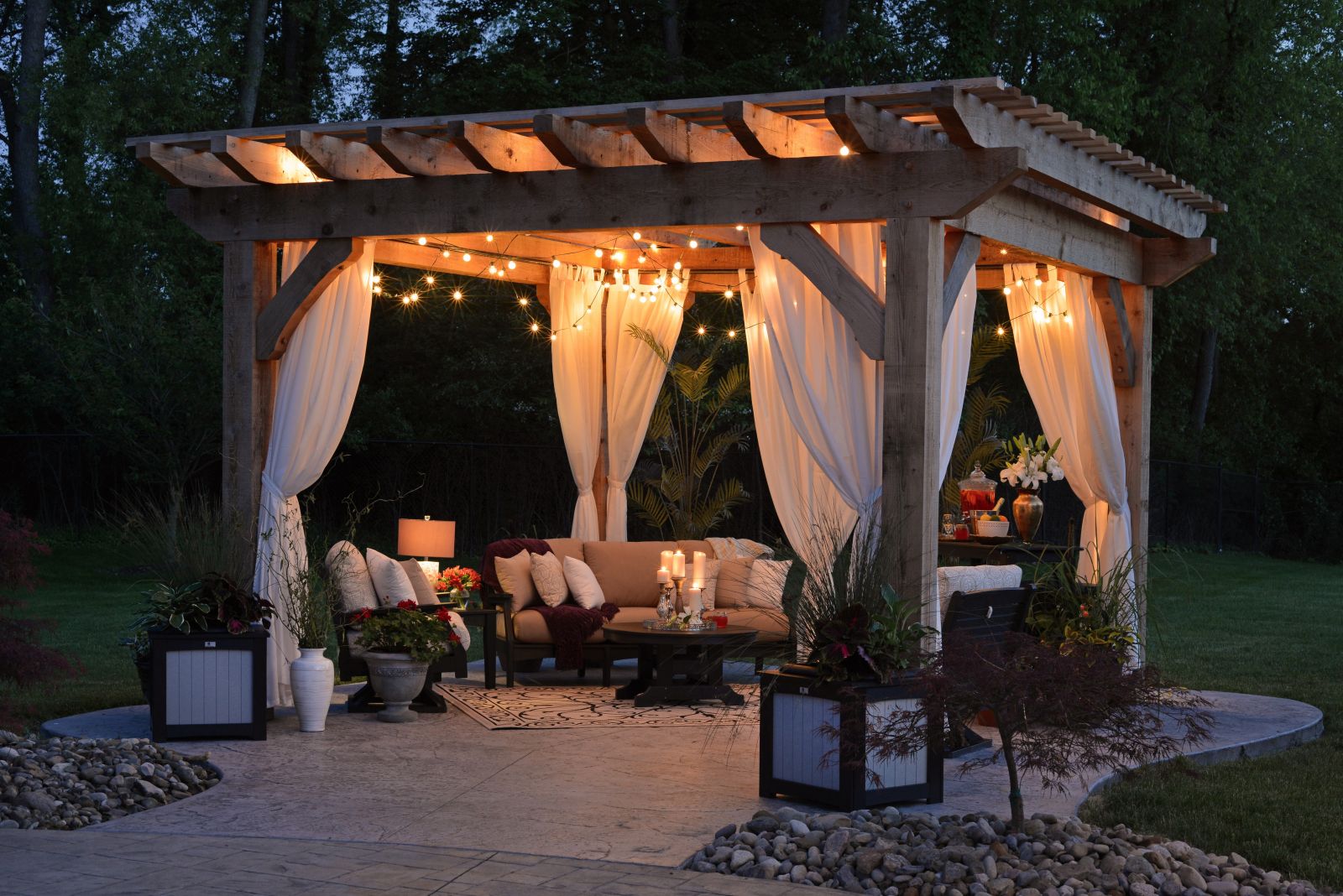Good news: that’s what patio heaters are for! You’ve likely seen these large pyramid or mushroom-shaped devices warming your favorite outdoor dining spot, but they’re also great for keeping your home outdoor spaces warm enough to enjoy throughout the year.
Curious about patio heaters, patio heater safety, and which kind of patio heater is right for you? Read on to find out!
What Are Patio Heaters?
A patio heater is exactly what it sounds like—a device to heat your patio. But there’s a lot more to them than that, and knowing the whole field before you buy will ensure you get the right heater for your needs.
First, let’s talk about how they work. Like any other form of heater, a patio heater uses fuel of some kind to keep a space warm. Patio heaters are designed for outdoor use, though they may also be suitable for covered porches and similar spaces depending on manufacturer specifications.
Patio heaters can be floor-standing, hanging, wall-mounted, or sit nicely on a tabletop. They can also include fire pits and chimineas, as both of those can also provide a good amount of heat to an outdoor space. Heaters frequently come in one of four forms: natural gas, electric, propane, and wood-burning.
Pros and Cons of Gas, Electric, Propane, and Wood-Burning Patio Heaters
Each fuel for patio heaters has different pros and cons depending on what you want to use it for. Consider each type as you’re weighing your purchase to ensure you get the right choice for your outdoor space.
Natural gas patio heaters are often chosen to make use of an existing natural gas line. Natural gas burns cleaner than wood, and patio heaters of this type are easier to maintain than some other options. However, because they’re attached to a natural gas line, they should be professionally installed and are therefore generally more expensive up front. They are also less portable than other models due to their need to be attached to a gas line.
Electric is another popular option, particularly as they are easy to use, somewhat portable, and safe to use in enclosed spaces. However, electric patio heaters may cost more in the long run due to electrical rates, and they do have to be located close to an outlet. Electrical patio heaters may also be slower to heat up than some other styles, but that depends somewhat on the individual heater.
Propane patio heaters are a great option as well, as they heat quickly and can be easily moved from one spot on the patio to another. However, propane tanks are more expensive than natural gas and tanks do require replacement. They are also generally not recommended for covered spaces, though you should always consult the manufacturer’s instructions to check.
Finally, wood-burning patio heaters, fire pits, and chimineas are one of the most affordable options. The trade-off is more frequent maintenance, as ash and coals should be cleaned out frequently. They are also harder to light and produce sparks and embers, which can be unsafe if left unattended.
How Many Patio Heaters Do I Need?
For a small home patio, one heater will generally be enough to heat the space to a reasonable degree. But if you have a larger space or a particular temperature you want to reach, you’ll need to do a little math.
To begin with, patio heater output is measured in British Thermal Units, or BTUs. One BTU measures the energy required to heat or cool one pound of water my one degree at sea level. You’ll likely see patio heaters with an output of BTUs in the thousands or ten-thousands.
First, we’ll find out how many BTUs we need to heat a patio by multiplying the cubic footage of our patio by how many degrees we want to raise the temperature.
In Seattle, the average January temperature is around 42 degrees Fahrenheit. If we want to warm it up to a cozy 70 degrees, that’s a 28-degree difference. Let’s say our patio is a nice 32 feet by 50 feet, and we want to heat it up to about six feet in the air. That’s 9600 cubic feet, multiplied by a 28-degree rise in temperature, to total 268,800 BTUs require to heat our space.
Next, we take the number of BTUs required divided by the BTUs of a particular patio heater model to tell us how many heaters we’ll need. If we take a popular patio heater, which puts out 41,000 BTUs in a circle, we’d need seven of them to fully heat our entire patio to 70 degrees.
How many heaters you need depends on how big your patio is, how much of it you actually want to heat, and how much you want to heat it. Be sure to calculate for all three variables to ensure your heaters are strong enough to heat your space!
Is a Patio Heater Worth It?
There are a lot of factors to consider when looking into a patio heater for your home. Not only are there multiple styles to consider, but there’s also the option to rent or buy. We’re here to help!
Should You Buy or Rent a Patio Heater?
Because patio heaters are so popular for outdoor events, there are lots of rental options available. However, rental isn’t necessarily the best option—it depends on what you’re looking for.
For example, say you’re planning a backyard reception for your son’s wedding in November so you can enjoy the crisp air and fallen leaves. You plan on having guests outside from about five PM into the wee hours of the morning, so you’ll likely need a full day’s rental. Rentals range from around $75 to $125, and BTU output varies as well, so you may need to rent more than one.
On the other hand, patio heaters start at around $70 and sell for up to $400, depending on size, BTU output, and design. Prices between buying or renting patio heaters aren’t that different if you do some shopping around, and you’ll have more freedom to choose if you purchase rather than rent.
However, if you don’t plan on using your patio heater more than once, renting may be a better option. Weigh the cost of the rental or new heater against factors like convenience, BTU output, design, and so on to figure out which option is best for you.
Patio Heater Versus Fire Pit: Which is Better?
Technically speaking, a fire pit can be a kind of patio heater. However, many people want to weigh a typical fire pit against a patio heater when making a decision, as they serve different primary and aesthetic functions.
| Patio Heaters | Fire Pits | |
|---|---|---|
| Safety | Generally safe, if properly installed and weighted. Does not give off sparks, though it is hot to the touch. | May be dangerous for small children and pets. Gives off sparks and embers, which can escape the fire pit area. |
| Temperature Control | Large degree of temperature control with the ability to switch on and off as necessary. | Temperature control requires moving and rearranging logs in a wood-burning fire pit, but may be easier with a gas or propane one. |
| Heating Space | Can heat a large space efficiently. | Typically heats only the surrounding area. |
| Lighting | Lights are not standard, but some models may include them. | Provides heat as well as light. |
| Aesthetic Appeal | Models vary, but are usually designed for function over form. | Fire pits suggest warmth and coziness, and many are designed for aesthetic appeal. |
| Ignition | Most patio heaters are turned on or off with a simple switch. | Wood-burning fireplaces must be built up using kindling and a starter. Propane or gas fire pits may be started with a button. |
| Multiple Uses | Patio heaters are typically used only for heating. | Fire pits may also be used as a light source or for cooking on. |
Are Patio Heaters Environmentally Friendly?
As people become increasingly conscious of sustainability issues, they also become curious about the environmental impact of their outdoor life, particularly when it comes to heat. Are patio heaters environmentally friendly?
That depends. According to one book, running one patio heater most evenings and some lunchtimes can produce four tons of carbon dioxide per year, roughly equivalent to two-thirds of the carbon dioxide output of an entire household. Most people will use their patio heaters less than that, but they do have a measurable effect on the environment if that’s a concern for you.
The environmental effects of fire pits aren’t quite as clear, but experts say that you should only burn seasoned firewood in small, hot fires to limit smoke production. Fires should also be limited to times when there is no fire danger and when air quality is not already affected by pollution or wildfire smoke.
Natural gas and propane burn cleaner, producing no smoke or odor, so they may feel more environmentally friendly. However, they are not environmentally neutral—like any electric, propane, or natural gas device, they still consume energy and potentially produce carbon dioxide. If you’re concerned about the environmental impact of your patio heater, limit your use to when it’s most needed and ensure that you follow all instructions.
Are Patio Heaters Safe?
Any heating device can cause personal injury, damage, or fire if used incorrectly. The best way to safely use a patio heater of any kind is to follow all manufacturer instructions, limit direct contact with the heater, and give the heater plenty of empty space surrounding it.
One of the major questions people have about patio heaters is whether they can be used in certain settings.
| Under a Roof | On a Screened-in Porch | Under a Tent | In a Gazebo | On a Deck | On a Covered Porch | |
|---|---|---|---|---|---|---|
| Natural Gas | No. | Check manufacturer instructions. | Check manufacturer instructions. | Check manufacturer instructions. | Yes. | No. |
| Electric | Yes. | Yes. | Yes. | Yes. | Yes. | Yes. |
| Propane | No. | Check manufacturer instructions. | Yes. | Yes. | Yes. | No. |
| Wood-Burning | No. | No. | No. | No. | Yes, but watch for escaping embers. | No. |
Another major concern for many patio heater owners is how to keep them from tipping over and potentially starting a fire. Many models come with an auto shut-off triggered by tipping the unit, but it’s best to be on the safe side and ensure that your patio heater is firmly weighted and anchored. This is especially true if you live in an area with high winds.
Also, be sure to check whether your patio heater needs to be covered or taken inside after use. Whether a patio heater is waterproof or not depends on the manufacturer, but it’s generally a good idea to have a cover for it anyway to prevent water, insects, and other debris from getting inside the heater. You may not be able to prevent all debris, but a cover will help protect it from the elements.
Your patio heater should also be cleaned regularly, once a year at minimum. This helps reduce the buildup of dust and other debris, which could increase the fire danger or simply make your patio heater stop working.
A patio heater is a great addition to any outdoor space—more heat means you can keep enjoying the great outdoors year-round. Don’t let the cold chase you inside before you’re ready; get yourself a heating option and maximize your outdoor space even as the weather gets chilly.
Ready to design your dream outdoor space for year-round enjoyment? Contact the Transblue franchise nearest you to learn more about how you can turn your backyard into an outdoor palace!
By Melissa Brinks
Melissa Brinks is part of Transblue’s marketing team. She enjoys relaxing outside with her dog and an ice-cold can of Cran-Raspberry La Croix.
Source: https://transblue.org/patio-heaters-what-you-should-know/




Leave a comment
This site is protected by hCaptcha and the hCaptcha Privacy Policy and Terms of Service apply.